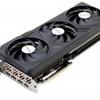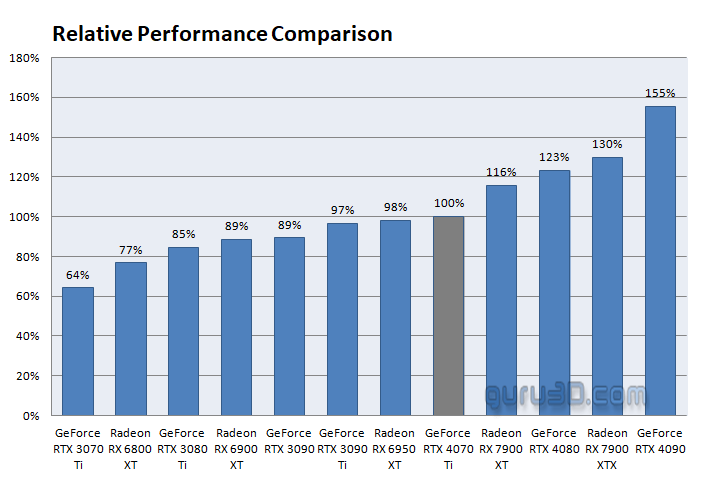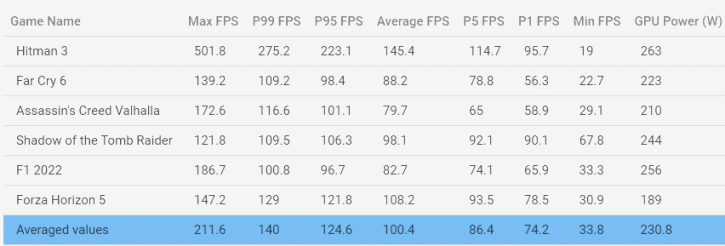Final words and conclusion
Final words
We can not squabble that the GeForce 4070 Ti is a significant step down in performance from the 4080 (~25%) and 4090 (~55%), but it is still breathtaking performance as the card sits at 3090 Ti performance levels. In terms of raw shader performance, this product outperforms the previous gen product significantly. We should also mention the vast improvement in raytracing speed and the addition of raytracing capability. This time, though, NVIDIA is relying even more heavily on DLSS, with dramatically improved Tensor cores that aid DLSS 3.0, which now delivers a twofold performance improvement. NVIDIA claims a 3x or 4x performance improvement with the proper implementation of future titles, which are impressive numbers. There is debate over what the frame injections bring to the table other than more incredible framerates. But, in the end, it is the eye candy on your monitor that counts, and we are not at all displeased with the end result. NVIDIA's high-end class graphics cards face and contend with two obstacles, the first of which is pricing. Starting at $799 but most likely finishing at the 1000 EUR level, these cards have entered a price range that is still not attainable to most people. PC gaming has become increasingly expensive, driving end users to other solutions. Admittedly, the new power connector keeps raising concerns, with no clarity coming from NVIDIA. It's not that it's not a safe connector; it's just that bending them too close to the connector combined with sometimes poor quality can lead to precarious situations. If you need to bend that cable, do it 3-4cm above the connector level and make sure it's plugged in deeply and tightly. All and rally, ALL cards we have tested to date we have checked on connector level with FLIR imaging, and for us, none ever and whatsoever has shown an issue.
Performance
You've seen the numbers, and we've already let the cat out of the bag. It all comes down to gaming performance and, of course, rendering quality. Yes, the RTX 4070 Ti provides more value for the money than seen from the 4080. We're getting nearer to raw performance levels enabling gaming at 4K resolution. Most enthusiast gamers play at UWHD, QHD, or UHD monitor resolutions. This card is designed for precisely that kind of gamer.
The old rasterizer engine breaks right through the previous limit of extreme performance. The RTX 40 series now has a new generation of Ray tracing and Tensor cores that are more powerful. So, do not let the specific RT and Tensor core counts fool you; it's all about how much performance one unit offers. Since they are close to the shader engine, they have become more efficient, which shows. Tensor cores are harder to measure, but from what we have seen, everything seems to be in good shape, as DLSS3 shows exciting values. Overall, the GeForce RTX 4070 Ti makes sense at resolutions as low as 2K 2560x1440, up to 4K (3840x2160).
Cooling & noise levels
Under heavy full load, the card tested uses about 250~260 Watts (average). This Wattage is directly related to how much heat the GPU, which sits inside a closed case, gives off. For acoustics, we reached 37~38 dBA in highly stressed conditions. It took a while for the card to get there (it warms up slowly), but even that is considered a typical or average acoustic value. Expect the card to get close to 60-65°C when stressed. This value can increase depending on how well air moves through your chassis. FLIR imaging doesn't show anything scary. Also, keep in mind that if you go for a custom card from a board partner, the power consumption levels will likely be higher due to increased TGPs and stuff like RGB and liquid cooling pumps.
Energy consumption
We touched the topic a bit in the previous chapter; the power draw under intensive gaming for GeForce RTX 4070 Ti is moderate, especially when energy prices are soaring; this product isn't a good example. We measured it to be close to the 260 Watt range (TBP). This is the tradeoff for a bit more bite in performance for this graphics card model in particular. Gaming wise that number will fluctuate a bit; however, 250+ Watt it'll do in no time. We expect the board partner cards to show higher numbers as they get more TGP allowance. When looking at TGP we write down an average power consumption of 230W (TGP) at Ultra HD.
Coil whine
Any GeForce RTX 4070 Ti can exhibit coil squeal. It's just a matter of how much exactly. Well, it's at a level you can hear when you hit high framerates. In a closed chassis, that noise would fade away in the background. However, with an open chassis, you can hear the coil whine/squeal. Graphics cards all make this in some sort or form, especially at high framerates this can be perceived. It's as good as it can get, and we have not been bothered by it at all.
Pricing
The NVIDIA GeForce RTX 4070 Ti is set at an MSRP of USD 799, which is a lot for something that can be used to play PC games. I feel that prices for a GPU should at least be under the price of a modern-age console. Premium AIB card designs will cost even more. Now, I can say all kinds of rude things about prices, but these products will still sell no matter what I say.
Tweaking
The card tweaks well. You receive a proper power limiter in Watts with the tested card, set at a +19% power limiter, so that's your first and quickest option to tweak. You get extra perf on the card's default power budget. The clock frequency can take a good +125 MHz extra. Apply it, and you'll see the GPU boost clock hovering at the 3000 MHz domain (frequencies vary per game title as they are dynamic). The memory could be tweaked to 25 Gbps, so all these are terrific values that brought 7~8% additional performance on challenging GPU situations, measured from reference performance.
Conclusion
To sum it all up, the GeForce RTX 4070 Ti provides a proper gaming experience. Comparing apples to apples, it sits (give or take) at 3090 Ti performance. And comparing apples to oranges, the closest comparative is the Radeon RX 6900/6950 XT and 7900 XT. The choice in-between 4070 Ti and 7900 XT is a complex one. The RTX offers better raytracing performance and adds the bonus of DLSS3. The 7900 XT, however, is a notch faster in the rasterizer engine backed by the additional L3 cache. The 12GB this card offers also is enough for the time being with most titles and the combination of Ultra HD. The ADA GPU architecture will cut through games with surgical precision and perform skillfully and competently. A good chunk of extra shader cores brings in nearly 1.5x raw shader performance and even faster Raytracing, and Tensor cores offer more performance. Underlying technologies like Shader Execution Reordering (SER) and DLSS 3.0 make the new product and Series 4000 shine. In closing, the GeForce RTX 4070 Ti impresses and will make you happy, but at a substantial cost. Despite the excellent perf per watt ratio, the energy consumption levels remain on the high side (relatively). What the PC Gaming market needs are more affordable graphics cards, and the 4070 Ti seems to be priced a notch too high, making people delay their upgrade. The market screams for reasonable performing sub-500 USD products.
Sign up to receive a notification when we publish a new article.
Or go back to Guru3D's front page
- Hilbert, LOAD"*",8,1.




